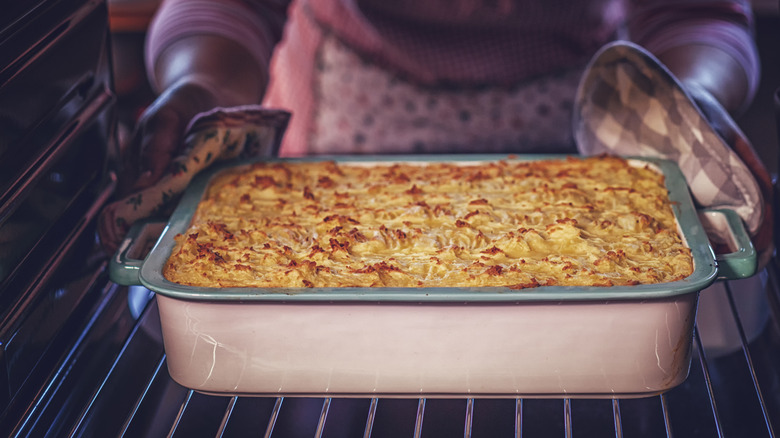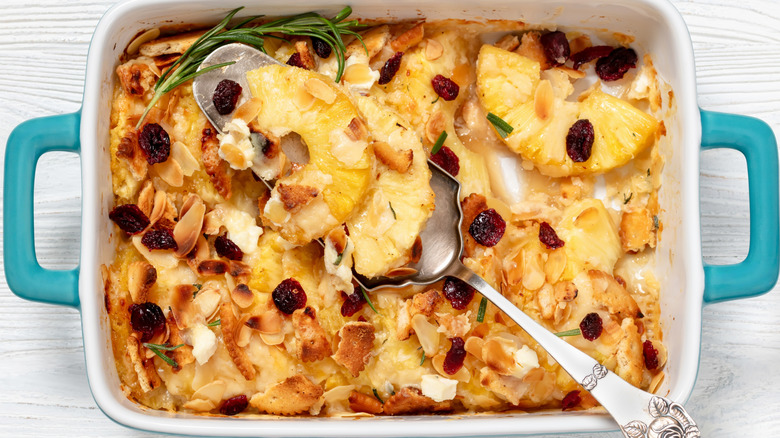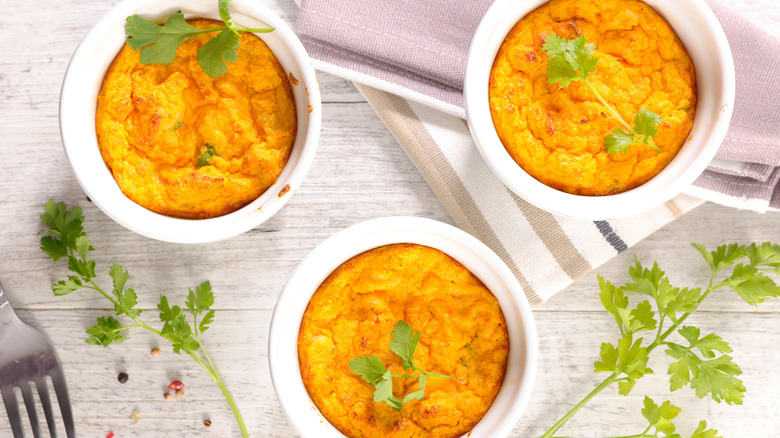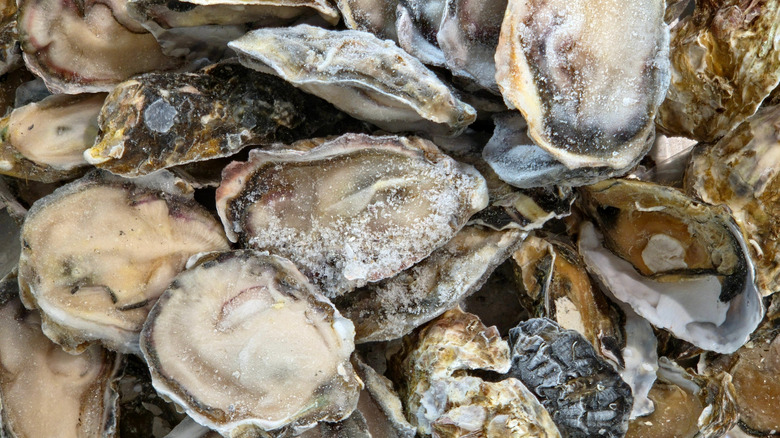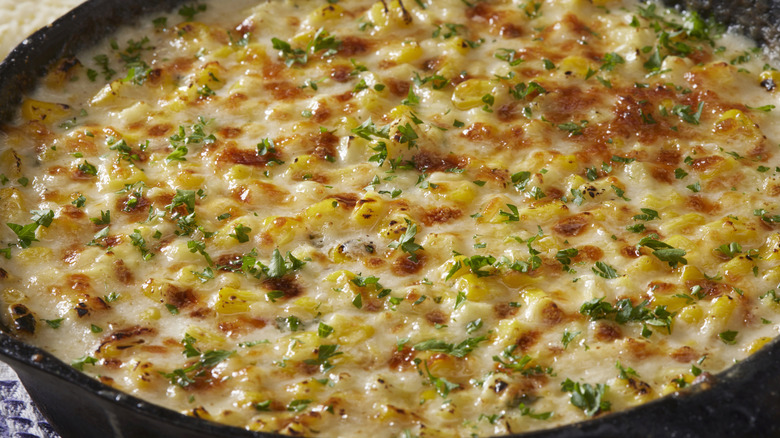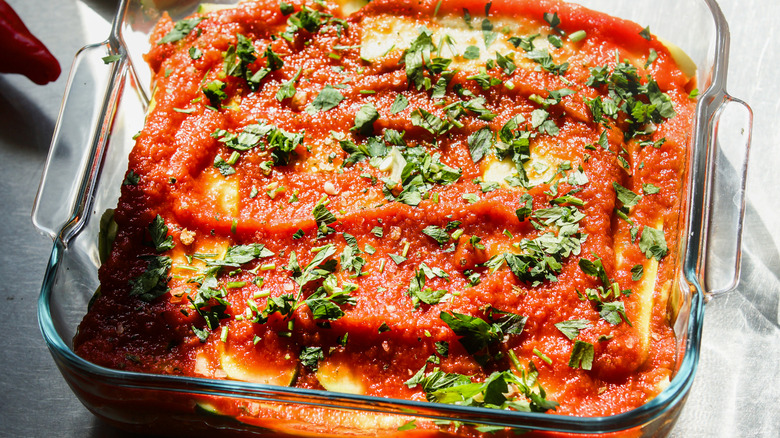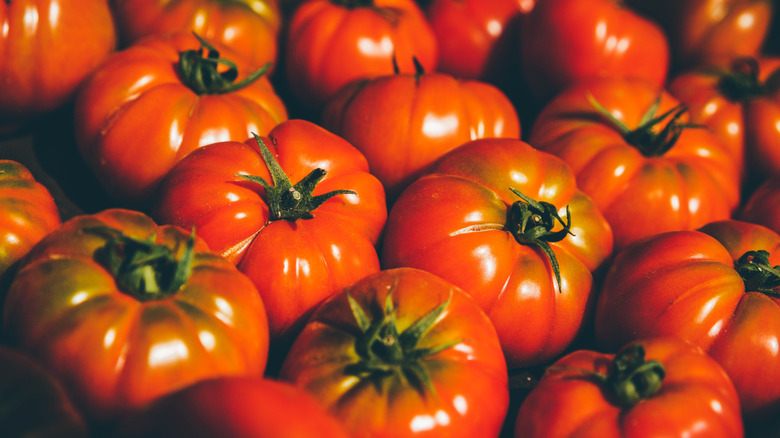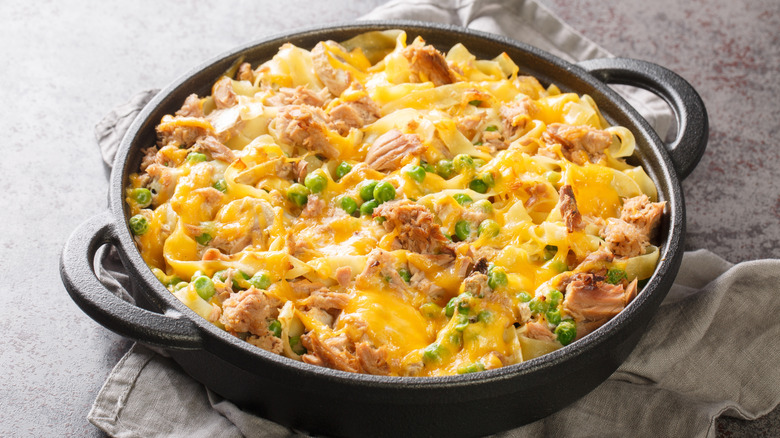10 Classic Casserole Dishes People Hardly Make Anymore
If you grew up in Middle America, you likely have fond memories of casseroles, even if you didn't call them that. In the upper part of the Midwest, for example, your favorite might be called a hotdish. Otherwise, you might simply refer to the meal as a bake (a breakfast bake, a pasta bake, etc.). If the recipe is cooked in a single pan in the oven, though, and especially if it's topped with a layer of melted cheese and/or breadcrumbs, it's a casserole — and, in the middle of the 20th century, it was all the rage.
The casseroles of the 1950s relied heavily on pantry and freezer staples, with the goal being to stretch leftovers and dollars as far as possible. Home chefs loved the simplicity of the dump-and-bake preparation, which allowed them to multitask on busy weeknights. The downside was that the flavors of pre-made ingredients often dominated the dishes, making them all, more or less, taste the same.
Dating back to ancient Greek etymology and the 1700s, the word "casserole" can now have negative connotations, conjuring unappetizing images of cream-based slop. For too many years, too many subpar meals turned us off casseroles, despite their persistent ease, frugality, and versatility. By considering the quality of ingredients and taking inspiration from other culinary traditions, we can certainly revamp the retro casserole. But first, we must learn from the past by looking back at ten classic casserole dishes people hardly make anymore.
Chicken Divan
While it's now thought of as an old-fashioned comfort food, Chicken Divan has surprisingly fancy roots. It was born at (and named for) Chef Anthony Lagasi's Divan Parisien restaurant, housed within the long-gone Hotel Chatham in New York. By the 1940s, crowds of discerning diners were flocking to sample Lagasi's signature dish, which featured sliced chicken breast and broccoli bathed in a bubbling béchamel sauce. After the building was demolished in 1966, those same diners clamored to recreate the recipe in their own kitchens, and thus a fine dining entrée became a homestyle meal.
The original cooking directions were never divulged, leaving home chefs to their own devices. The result is the variety of Chicken Divan recipes you'll find today. Some start with an old-school béchamel, while others suggest a simple swap of canned cream of chicken soup. The broccoli can be fresh or frozen, and the chicken can be poached, sautéed, or cut from a pre-made rotisserie. Whether you go the from-scratch route or cut a few corners, you'll wind up with a hot and tasty dish: creamy, cheesy chicken and broccoli, topped with a golden-brown cracker-crumb crust. Given how cozy and delicious chicken divan is, it's surprising that this classic casserole is so rarely made today.
Turkey Tetrazzini
A mention of Turkey Tetrazzini is likely to start a conversation about Thanksgiving leftovers. Given the fact that the dish prominently features the occasion's number-one protein, that makes sense. What doesn't is that, for the rest of the year, this classic casserole is basically forgotten.
Turkey Tetrazzini has been around since the early 1900s, when variations made with chicken or seafood were popular. Its name (for 20th-century opera star Luisa Tetrazzini) and use of spaghetti might be Italian, but the dump-and-bake convenience feels like a hallmark of midcentury American cooking. Many of the ingredients (pasta, peas, cream of mushroom soup) can come from the pantry or freezer, making this one that busy home chefs can reach for on a weeknight. Yet, the affordable and easy-to-make meal is rarely thought of today, aside from as a way to use up holiday turkey.
The waning popularity of Turkey Tetrazzini is likely due to changing preferences and our evolving understanding of nutrition. A creamy pasta bake is no longer considered a healthy choice by many, nor is a reliance on pantry staples as attractive as it once was. The main ingredients are also quite bland, meaning that if you don't season your casserole properly, you'll likely be underwhelmed. Do it right, though, and you'll be happy that you revisited this old-school comfort food.
Pineapple casserole
If you've never heard of pineapple casserole, you're probably not from the American South, where the polarizing potluck dish is the topic of frequent debate. Is the sweet-and-savory creation a side dish or a dessert, delicious or a disgrace? You'll have to decide for yourself — after you try it, of course.
Pineapple casserole is, of course, packed with plenty of pineapple that typically comes from a can, where it's been marinating in its own juices for extra sweetness. The chunked and crushed tropical fruit is mixed with even more sugar and flour, and the ingredient responsible for making the dish so controversial: shredded sharp cheddar cheese. Top the mixture with crumbled Ritz crackers and melted butter, pop it in the oven, and bring it to your next party. The unexpected dish might help you make some new friends, especially if you're in South Carolina, where pineapple casserole was (according to The New York Times) the state's most-googled Thanksgiving recipe in 2014. Since then, it's become hard to come by, especially in other parts of the country.
Cheesy carrot casserole
The rich yet humble casserole can be a main dish or a side, and is equally mouthwatering either way. Cheesy carrot casserole is a great example of the latter, best served alongside a traditional roast for a cold-weather feast. The combination of root vegetables and melted cheese, held together with breadcrumbs and cream sauce (or cream of mushroom soup), evokes feelings of comfort and nostalgia for those who grew up enjoying this classic casserole. Interestingly, among its fans are George Washington himself. To this day, the dish is served at the historic Mount Vernon Inn Restaurant, where early American cuisine and traditions are still celebrated.
Despite a heritage richer than its hearty ingredients, cheesy carrot casserole is rarely seen on the dinner table nowadays. This is likely due to declining demand for casseroles in general, as modern inventions and sensibilities allow us to enjoy a wide array of fresher, healthier carrot recipes. When you're craving something more decadent than a salad, though, this old-school dish might be one to reach for.
Shepherd's pie
Like many of our oldest dishes, shepherd's pie was invented out of necessity. When early settlers of the British Isles realized that mashed potatoes could be used to preserve leftover meat, it became a standard topping, safely encasing ground beef or lamb (depending upon where you were originally from) and vegetables to be enjoyed later.
The first official reference to shepherd's pie appeared in Scotland in 1849, but that's only because it was previously called cottage pie. The earliest renditions of the dish didn't follow a formal recipe, meaning that the filling could contain all manner of ingredients. It was considered a lowbrow meal, eaten more for utility than pleasure. When the use of mashed potatoes became standard in the 18th century, public perception of the casserole slowly changed. Eventually, shepherd's pie was seen as respectable, even craveworthy, and Scotland and Ireland fought over who thought of it first.
Regardless of its precise lineage, shepherd's pie remains popular in pubs throughout the U.K. But despite its reputation across the pond and the fact that shepherd's pie is easy to make, the classic casserole is rarely baked stateside.
Scalloped oysters
In the 19th century, cheap and abundant oysters were widely enjoyed by the American working class. They were eaten freshly shucked, of course, but also used as the featured protein in countless recipes, many of which have since fallen by the wayside. One such dish is scalloped oysters, a classic casserole made by layering raw oysters with bread crumbs and lumps of butter. The dish was baked slowly, allowing for the flavors to meld into a harmoniously savory and hearty meal.
Unfortunately, our appetite for oysters outpaced production, and they're no longer a cheap and easy food. These days, you're more likely to eat oysters at a fancy restaurant than you are to throw a bunch of them into a casserole dish and smother them with cream. The reason why scalloped oysters is a dish people hardly make anymore is no mystery. However, the endeavor might be worth the results, if you're game. To ensure optimal results, consider first fattening up your oysters by brushing them with saltwater to feed them, and avoid making more than two layers of oysters, as this may prevent the casserole from cooking properly. One thing you don't have to worry too much about? The outdated "R" month rule for eating oysters.
Scalloped corn
Chances are high that your Thanksgiving spread includes some sort of corn casserole. It might be a rich and savory cheesy corn casserole or a spicier Mexican cornbread casserole, but it's probably not scalloped corn. For whatever reason, the old-school dish has fallen out of fashion, and was even replaced by other sweet corn recipes in summer. Try it once, though, and you may be tempted to bring it back.
Originally from New England, where many foods are scalloped, scalloped corn features kernels mixed with cream sauce, topped with buttery cracker crumbs, and baked in the style of a gratin. Like any good casserole, it's hearty and highly adaptable, with a forgiving texture that allows for creativity. The seasonings are traditionally simple, but you can choose to add diced bell peppers for color or chiles for a little heat. You can serve it in the warmer months, making good use of fresh corn, or make a perfectly delicious version with frozen or canned corn in winter. There's no shame here in taking a shortcut; it's a casserole, after all. Substitute half the corn for creamed corn, and you're halfway to enjoying this tasty, yet rarely made, dish.
Shipwreck casserole
A retro dish with a mysterious moniker, shipwreck casserole was probably invented in the 1940s, and possibly named for the fact that any salvaged ingredients can be thrown into the mix. However, the leading theory is tied to the finished product's appearance, which can indeed resemble wreckage on a plate.
The main ingredients in this classic American casserole are ground beef, sliced potatoes or hash browns, and crushed or diced tomatoes that form the bright-red (and, yes, messy) top layer. Optional additions include diced vegetables, beans, rice,and sour cream — basically any remaining ingredients you need to use up. And if you're thinking that a proper casserole needs to have a crunchy top, feel free to make one out of cornflakes and melted butter. You won't regret it.
Its ease, frugality, and flavor made shipwreck casserole a family favorite through the 1970s. It's perfect for feeding a crowd with minimal fuss, a great way to use leftovers, and (thanks to both its adaptability and unusual name) an adventure to eat. We only wonder why this one-dish wonder is not made more often these days.
Tomato pudding
Also known as tomato crouton casserole, tomato pudding is a dish that toes the line between casserole and bread pudding, savory and sweet. The result is a food that can feel a bit confusing, especially in the American South, where it's commonly served at Thanksgiving (not exactly tomato season.) If you're brave enough to taste tomato pudding, though, you may just be rewarded with a new favorite flavor.
The exact origins of tomato pudding are unclear, but it's thought to have been invented as a way to extend the summer's harvest, and may have evolved from the baked tomatoes that enslaved people made. While it's built more like a cobbler, with biscuits topping overripe fruit, it was called a pudding presumably to satisfy British settlers. Its complex texture features chunks of stale bread (or croutons, if you will) baked in a tomato sauce that acts like custard, binding it all together.
Unlike other classic casserole dishes, tomato pudding has no melted cheese or cracker-crumb topping. Instead, its success relies on striking that perfect harmony of savory and sweet, browned and bubbling from the oven. Its fans will tell you that it's well worth trying, but you may have to hunt for tomato pudding, as it's a long-forgotten dish that people hardly make anymore.
Tuna noodle casserole
While it was being made in the Pacific Northwest as early as the 1930s, tuna noodle casserole is most often associated with the 1950s. That's when the American casserole craze hit its peak, and also when Campbell's cream of mushroom soup hit store shelves. As part of its concerted efforts to market the product as both a soup and a sauce, Campbell's introduced its own tuna noodle casserole recipe, branding the new pantry staple as a must-have shortcut to easy weeknight meals.
Along with Campbell's cream of mushroom soup, a midcentury tuna noodle casserole would typically include canned tuna, frozen peas, egg noodles, crushed saltines, grated Parmesan, and seasonings. From there, ingredients may be added or adjusted to amp up your tuna noodle casserole, but few recipes stray far from the basics.
From everyday eating to Grandma's Sunday dinners, tuna noodle casserole was everywhere for a while. Nowadays, though, it's rarely served. The decreased popularity is likely due to changing dietary preferences, as Americans learn new ways of preparing fresh ingredients and also shift their understanding of what constitutes a balanced meal. The idea that anything with a cream-sauce base can be healthy has gone out the window, and with it so many classic casserole dishes.
